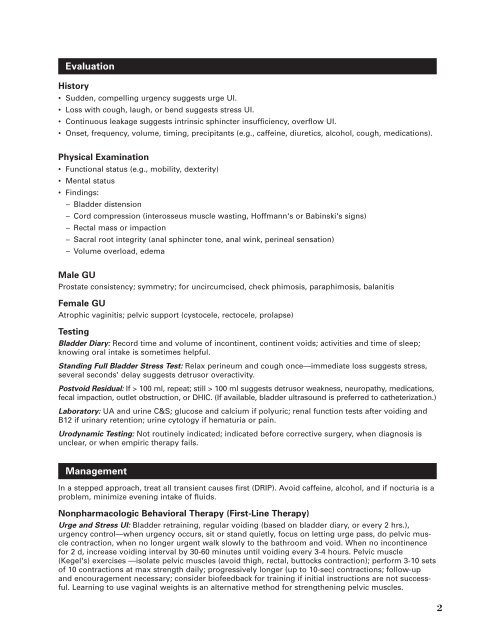Urinary Incontinence
Urinary Incontinence
Urinary Incontinence
Create successful ePaper yourself
Turn your PDF publications into a flip-book with our unique Google optimized e-Paper software.
EvaluationHistory• Sudden, compelling urgency suggests urge UI.• Loss with cough, laugh, or bend suggests stress UI.• Continuous leakage suggests intrinsic sphincter insufficiency, overflow UI.• Onset, frequency, volume, timing, precipitants (e.g., caffeine, diuretics, alcohol, cough, medications).Physical Examination• Functional status (e.g., mobility, dexterity)• Mental status• Findings:– Bladder distension– Cord compression (interosseus muscle wasting, Hoffmann's or Babinski's signs)– Rectal mass or impaction– Sacral root integrity (anal sphincter tone, anal wink, perineal sensation)– Volume overload, edemaMale GUProstate consistency; symmetry; for uncircumcised, check phimosis, paraphimosis, balanitisFemale GUAtrophic vaginitis; pelvic support (cystocele, rectocele, prolapse)TestingBladder Diary: Record time and volume of incontinent, continent voids; activities and time of sleep;knowing oral intake is sometimes helpful.Standing Full Bladder Stress Test: Relax perineum and cough once—immediate loss suggests stress,several seconds' delay suggests detrusor overactivity.Postvoid Residual: If > 100 ml, repeat; still > 100 ml suggests detrusor weakness, neuropathy, medications,fecal impaction, outlet obstruction, or DHIC. (If available, bladder ultrasound is preferred to catheterization.)Laboratory: UA and urine C&S; glucose and calcium if polyuric; renal function tests after voiding andB12 if urinary retention; urine cytology if hematuria or pain.Urodynamic Testing: Not routinely indicated; indicated before corrective surgery, when diagnosis isunclear, or when empiric therapy fails.ManagementIn a stepped approach, treat all transient causes first (DRIP). Avoid caffeine, alcohol, and if nocturia is aproblem, minimize evening intake of fluids.Nonpharmacologic Behavioral Therapy (First-Line Therapy)Urge and Stress UI: Bladder retraining, regular voiding (based on bladder diary, or every 2 hrs.),urgency control—when urgency occurs, sit or stand quietly, focus on letting urge pass, do pelvic musclecontraction, when no longer urgent walk slowly to the bathroom and void. When no incontinencefor 2 d, increase voiding interval by 30-60 minutes until voiding every 3-4 hours. Pelvic muscle(Kegel's) exercises —isolate pelvic muscles (avoid thigh, rectal, buttocks contraction); perform 3-10 setsof 10 contractions at max strength daily; progressively longer (up to 10-sec) contractions; follow-upand encouragement necessary; consider biofeedback for training if initial instructions are not successful.Learning to use vaginal weights is an alternative method for strengthening pelvic muscles.2
















